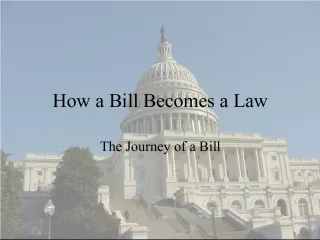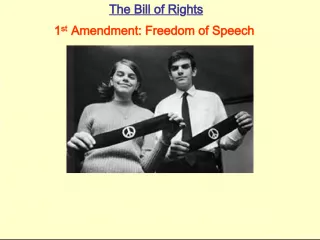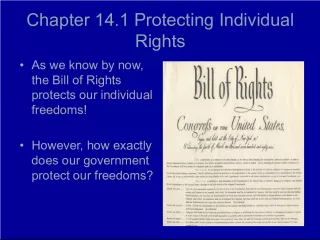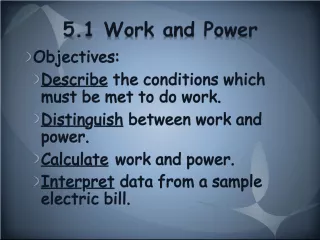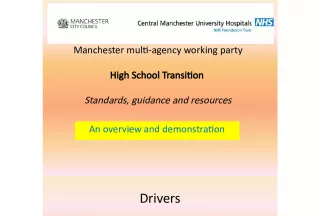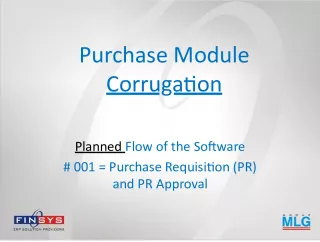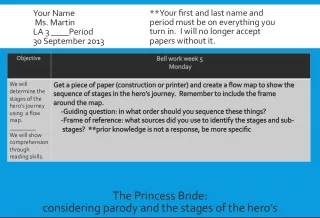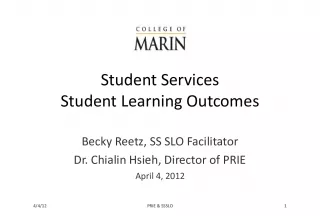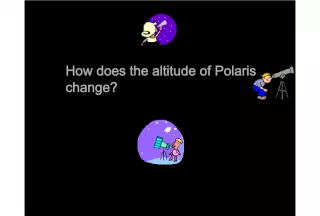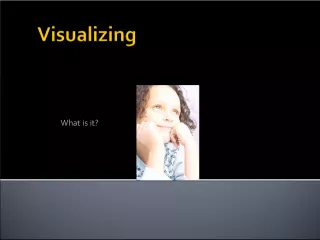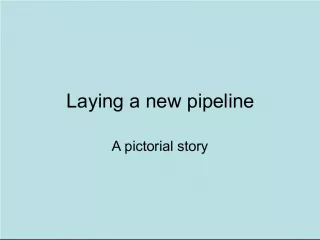How a Bill Becomes a Law: The Journey of a Bill


In this video titled "How a Bill Becomes a Law: The Journey of a Bill," viewers can learn about the process that a bill goes through to become
- Uploaded on | 0 Views
-
 agenor
agenor
About How a Bill Becomes a Law: The Journey of a Bill
PowerPoint presentation about 'How a Bill Becomes a Law: The Journey of a Bill'. This presentation describes the topic on In this video titled "How a Bill Becomes a Law: The Journey of a Bill," viewers can learn about the process that a bill goes through to become. The key topics included in this slideshow are . Download this presentation absolutely free.
Presentation Transcript
Slide1How a Bill Becomes aLaw The Journey of a Bill http://www.youtube.com/watch?v=KKvY0 Q3tI6I
Slide2Congress Makes Federal Laws Bill: a proposed law presented to the House or Senate for consideration. Usually deals with a single matter, could include a RIDER dealing with an unrelated matter. Follow the bill as it moves through Congress
Slide3Introduction of the Bill The bill can come from a variety of sources: Individual citizens, Special interest groups Corporations, Non-governmental organizations (NGOs) Only a member of Congress can introduce the bill A bill can start in either House.
Slide4The Bill is Assigned to Committee Each House has standing committees that consider their bills. Each committee has a chair (from the Majority) and a ranking member (from the minority). They “mark-up” (edit) the bill so it will pass on the floor. They can also “pigeonhole” or kill the bill in committee. The bill must also pass through the House Rules Committee.
Slide5The Bill is Reported To the Floor If the bill is passed by the committee, it is sent to the whole House for debate and vote. The committee has “reported the bill favorably to the floor.” The Speaker determines which bills are discussed and for how long. Committee chairs and ranking members give out time to debate to other members.
Slide6The Bill is Debated and Voted On in the House Bills can be considered by the whole House at once: called “Committee of the Whole” Votes are done electronically in the House. This is a role call vote. A tote board on the wall shows the tally. Red = oppose Green = Agree Yellow = Abstain Votes can be taken by voice “yeas and nays” or a “teller vote” where members file past the sergeant at arms. http://uk.reuters.com/news/vi deo/popup?videoId=91387&v ideoChannel=2603&pos=15. 6
Slide7The Bill Goes to the Senate The bill is sent to the US Senate. A Senate version is written with the letter S. and a number. House bills have HR. As in the House, the bill must be referred to the appropriate standing committee. Committees hold hearings and make changes to the bill. The committee can ‘report” the bill to the Senate floor.
Slide8The Bill is Debated and Voted On in the Senate The Senate Majority Leader determines which bills are scheduled, when and for how long. As in the House, the bill must be referred to the appropriate standing committee. Debate in the Senate is unlimited. Filibusters (talking bill to death) can be used by the minority to block bills. http://www.youtube.com/watc h?v=gZA77x- b8vE&feature=related 3/5 (60) of the Senate must agree to end debate (this is called “cloture”) The Senate Rules committee is much weaker than the House’s.
Slide9Both Houses Must Pass the Bill A simple majority in both houses is needed to pass the bill (51%). In the House: 218 needed to control the House. In the Senate: 51 senators needed to pass the bill (and control the Senate).
Slide10Differences Between Houses Must Be Reconciled Each house passes its own bill. Any differences must be ironed out and made into one bill. The bill is considered by a conference committee, made up of both House and Senate members. They negotiate and compromise and send the combined bill back to both houses. A vote on the “conference report” must be taken and passed by both Houses.
Slide11The Bill is Sent to the President The president can sign the bill if he wants it to become law. He can include “signing statements” that say how the law should be enforced or if parts will not be enforced. The president can veto or reject the bill. He must include his reasons and recommendations for correction. The president can choose not to act on the bill. If Congress is in session, the bill becomes law after 10 days. If Congress is not in session, the bill dies after 10 days. This is called a “pocket veto.”
Slide12The Bill Becomes Law If the president vetoes the bill, both Houses can reconsider the bill. Two-thirds (67%) of both Houses are needed to override the President’s veto. In the House: 369 needed for override. Senate: 67. If president signs the bill, it is a federal law that each state must follow.
Slide13Pork Barrel Spending Pork Barrel Spending: an unflattering term to describe spending projects that benefit a particular member’s district that are buried deep in appropriations bills. The huge list of federal projects, grants, and contracts available to cities, businesses, and colleges and institutions in a congressional district These projects are hidden in mandatory appropriations bills so they are guaranteed passage and to hide them from the general public and even other members of Congress. Why? Members do this to stay popular with voters and reward those that give them $ for their campaigns http://www.cbsnews.com/video/watch/?id=1913692n http://www.youtube.com/watch?v=DqRxNnjUEtM
